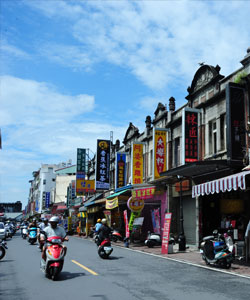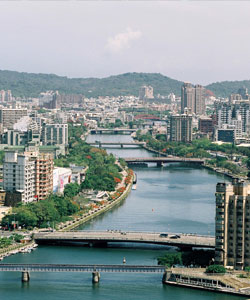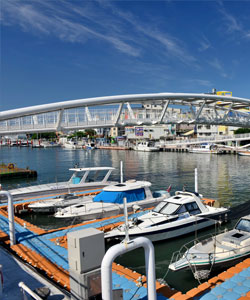          |
|
|
 Changing of City Centers Mark Kaohsiung's Transformation Over Time
Changing of City Centers Mark Kaohsiung's Transformation Over TimeOver the years, down through the generations, with every sunrise and sunset over the city, the history of Kaohsiung is recorded in earth and stone. The memories of the city are locked in the mountains, the sea, the rivers and the harbour. The city's many cultures are remembered through mountain songs and Hakka tunes. While the city's government leaves its traces in every move of the city center, the city's dreams take flight to the sky! The city center always serves as the heart of economic and everyday activity in every era. When we follow the footsteps of its ancestors and set out on a journey to rediscover its roots, what we find is not the dust of the campaign trail or gleaming cohorts but surviving ruins and historic buildings that provide a window to Kaohsiung's past. From the Old Zuoying Castle and New Fongshan Castle to the Xiwei Administrative Center, each move testified to a different period of prosperity. With the merger of the county and the city for the Centennial of the Republic, the dual administrative centers have defined a new shape for Greater Kaohsiung as well. Memories Locked in Stone at Zuoying Castle As you run your hands over the stone wall and read the worn lettering, it seems to take you back to three and a half centuries ago. Koxinga had just driven the Dutch from Taiwan and proclaimed the island the East Capital. Taiwan was divided into one prefecture and two counties, with "Wannian County" encompassing modern-day Greater Kaohsiung, Pingtung County and Greater Tainan. The county seat was located at Zuoying and this can be considered the first city center within the borders of Kaohsiung. When Taiwan was reorganized into one prefecture and three counties during the Qing Dynasty, the county seat remained in place. The city also became the first city in Taiwan to be fortified with a stone wall and moat. The surrounding area was filled with farms, temples and markets. The "Zuoying Wannian Festival" that the people of Kaohsiung look forward to so much every year is named after "Wannian County" and is an extension of contemporary traditional festivals. When we return to the "Zuoying Castle" today, it is no longer the political and economic hub it used to be. Modern-day Zuoying is a city of many different faces. It is not only situated at the junction of the High Speed Rail, Taiwan Rail and Kaohsiung MRT, it also retains old settlements, military dependents' villages and new urban developments. Reminders that Zuoying was once a prosperous administrative center can still be seen everywhere today.  Transformation of Takao Harbor into City Center
Transformation of Takao Harbor into City CenterJapan initially placed Taiwan under the rule of a governor-general. Administrative control of Kaohsiung City was moved from New Fongshan Castle to the Fongshan Sub-District of Tainan County. When the 8th governor-general abolished the district in favor of states, "Kaohsiung State" appeared for the first time as an administrative region. Development was initially centered around the Cihou region but the government began laying railways, upgrading the harbor, constructing railway stations and passed new urban plans. New industries such as refining, machinery, shipbuilding and cement were introduced as well. What is today Hamasen and Yancheng were at the time two reclaimed areas near the harbor that developed rapidly. The Kaohsiung State Government was established on Kaohsiung Street (what is today Kaohsiung District Court) and within a span of fifty years, Kaohsiung became the second largest city in Taiwan.  The Classical Beauty of Kaohsiung City Office
The Classical Beauty of Kaohsiung City OfficeIn the city center, a familiar Japanese building can be seen on the far bank amidst towering modern blocks. The building, designed by Japanese architect Yonejiro Ono, has a symmetrical Western classical exterior combined with traditional Japanese-style roof. It is currently the most well-preserved Japanese "Imperial Crown" style building in Taiwan. Now known as the "Museum of History", this was once Kaohsiung's second "City Office". In 1924 the district and town were abolished. Under the new system, Kaohsiung Town became Kaohsiung City. A "City Office" was also set up reporting directly to the Kaohsiung State. The first "City Office" was located in Gushan District at what is Daitian Temple today. The second Kaohsiung City Office was built in 1938 (13th year of the Showa Era) and commissioned in September 16 of the following year. At the end of World War II in 1945, the "City Office" was renamed "Kaohsiung City Government" and remained the city's administrative center until 1992. After the relocation of the city government, the decision was made to convert the historic City Office building into the Kaohsiung Municipal Museum of History. The new museum was opened in 1998 and now plays a new role in the lives of Kaohsiung residents by preserving and promoting the history and culture of Kaohsiung. Kaohsiung City Government's Xiwei Administration Center A fast-growing population and rapid industrial/commercial development meant that Kaohsiung City Government had to expand as well. In 1992, the city government moved from Zhongzheng 4th Rd. to the new city hall on Xiwei 3rd Rd. in the Lingya District to provide the people with a better quality of service. The joint office building oversaw Kaohsiung's transformation over the last two decades and has become a familiar sight to city residents. The sunlight shining through the skylights, the greenery on the balconies as well as the smell of coffee wafting from the central courtyard all helped to make visitors feel at home. In 1946 Kaohsiung City consisted of 10 districts: Yancheng, Gushan, Zuoying, Nanzih, Sanmin, Sinsing, Cianjin, Lianya (renamed Lingya in 1952), Qianzhen and Qijin. In 1975, the city's total population exceeded 1 million. To balance development between north and south, Kaohsiung County's Xiaogang Township became a district of Kaohsiung City. Kaohsiung was also upgraded from a provincial city to a municipal city with a total of 11 districts in July 1979. The city government continued to expand during its time at this administration center to oversee many important developments. These included reparation and beautification of the Love River and harbor district, the refurbishing of cultural and leisure facilities, the construction of many important public infrastructure projects, the building of the MRT system and the hosting of the 2009 World Games. These developments helped to gradually transform the face of the city. The Twin City Centers of Xiwei and Fongshan Define New Aspirations for Kaohsiung In July 2009, the Executive Yuan approved the amalgamation of Kaohsiung County and Kaohsiung City. The merger officially took effect on December 25, 2010. Greater Kaohsiung now consists of 38 districts and 893 wards. For the people of Kaohsiung City, this represented the start of a new era as well as a continuation of the bid to realize the common goal of "Happy Greater Kaohsiung". The new Kaohsiung City's administration is now split between the old Kaohsiung City Government and the old Kaohsiung County Government. These have become the Xiwei Administration Center and the Fongshan Administration Center of Kaohsiung's "dual city center" structure. The city government continues to operate with 30 tier-1 administrative agencies including 23 bureaus, 4 departments and 3 commissions so the people can gradually familiarize themselves with the new Greater Kaohsiung. Having two city centers is akin to having two suns within the city lighting up every corner of Greater Kaohsiung. By providing all 2.77 million residents of the city with attentive service and a vision for happiness, the twin centers help to bring all city residents closer together as well. |